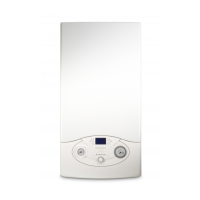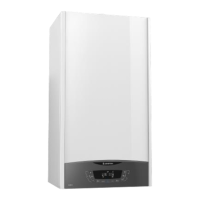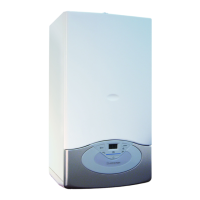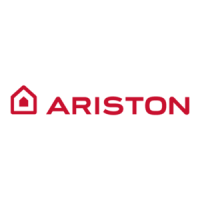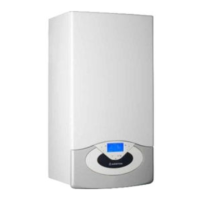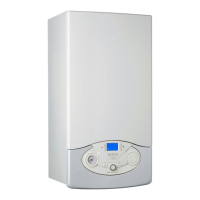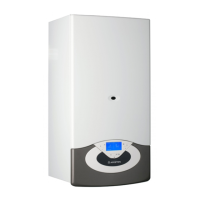Supplied By www.heating spares.co Tel. 0161 620 6677
53
If these solutions do not cure the fault, call a qualified professional
19. Incorrect function (continued)
Fault Cause Solution
The boiler doesn’t start
No gas, no water or no
electricity
Control gas, water and electrical
supply, fuses…
Air in the gas pipe Purge the air from the gas pipe
Room thermostat switched off Turn the room thermostat up
Red indicator alight
Overheat lockout (A01)
No flame after safety time (A03)
No flame detected (E04)
Flame lift (E18)
Wait for a few minutes
Press the reset button 29 (Fig. 113) the red led goes out
and the boiler attempts to re-light.
If the red indicator lights too frequently, please call your
local service centre.
Noises in CH system
Air presence in CH system or.
Insufficient pressure
Purge the system of air (Section 14.2, page 28) and
increase the system pressure (Section 2, page 6)
Radiators rise in temperature
During summer season
Gravity effect in the CH system
Close the heating flow isolating valve (41 Fig. 2, page 5).
Don’t forget to open it again before starting the heating.
If after A01 fault and with cold
boiler, The boiler doesn’t start
Overheat lockout (A01)
Check the thermo fuse on the right top on the heat
exchanger. With an open thermo fuse, a replacement of
all the heat exchanger is required.
20. Maintenance
20.1 General remarks
It is recommended that the following inspections be carried
out on the boiler at least once a year;
1. Check the seals in the water group, and if necessary,
replace the gasket and restore the seal to perfect working
order;
2. Check the seals in the gas group, and if necessary
replace the gaskets and restore the seal to perfect
working order;
3. Visually check the overall condition of the boiler;
4. Visually check the combustion, and if necessary,
disassemble and clean the burner;
5. Following inspection 3, disassemble and clean the
combustion chamber as necessary;
6. Following inspection 4, disassemble and clean the
injector, if necessary;
7. Clean the primary heat exchanger. (see Section 20.2);
8. Check and adjust the CO
2
emissions as necessary (see
Section 14.3);
9. Check the correct operation of the heating safety devices:
- Overheat thermostat
10. Check the correct operation of the flow switches;
11. Check the correct operation of the low pressure switch;
12. Check the diverter valve movement;
13. Check the correct operation of the gas group safety
devices:
- absence of gas or flame safety device (ionisation);
14. Check that the electrical connections are correct (as
described in Section 13, page 27 Fig 38);
15. Check the efficiency of the production of domestic hot
water (test the flow rate and temperature rise);
16. Carry out a general inspection of the boiler;
17. Check the flue and termination point;
18. Remove any oxide from the detection electrode by using
an emery cloth.
20.2 Cleaning the primary exchanger
Cleaning the exhaust side
Remove the air gas assembly (Section 18.2.1). Check that
the exhaust passages are free, if there are deposits present,
clean the exchanger with compressed air or wash with water
or a vinegar based detergent.
Cleaning the water side
Use detergents that dissolve CaCO3. Leave to act for a
short time and then rinse.
Make sure that the detergent does not remain inside the
exchanger.
20.3 Operational test
Unscrew the lower part of the condensate trap and clean it.
Fill it with water and replace.
After carrying out the maintenance operation, fill the heating
circuit to a pressure of approximately 1.5 bar and release the
air from the system. Also fill the domestic hot water system.
- Place the boiler in operation.
- If necessary, release the air again from the heating
system.
- Check the settings, seals and the correct functioning of
the system for expelling the products of combustion and
drawing combustion air.
- Check the settings and correct operation of all the
control, regulation and monitoring components.
- Check that the burner ignites properly and carry out a
visual check of the burner flame.
- Check that the 3 bar safety valve is operating correctly.
- Check the operation of the time control and room
thermostat (if fitted).
N
OTE:THESE CHECKS ARE NOT EXHAUSTIVE
ONCE THE BOILER HAS BEEN SERVICED IT IS NECESSARY TO
COMPLETE THE SERVICE INTERVAL RECORD (SECTION 24, PAGE
58)
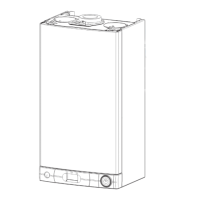
